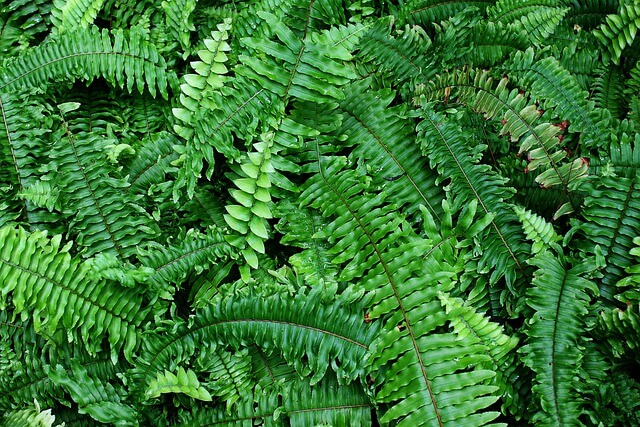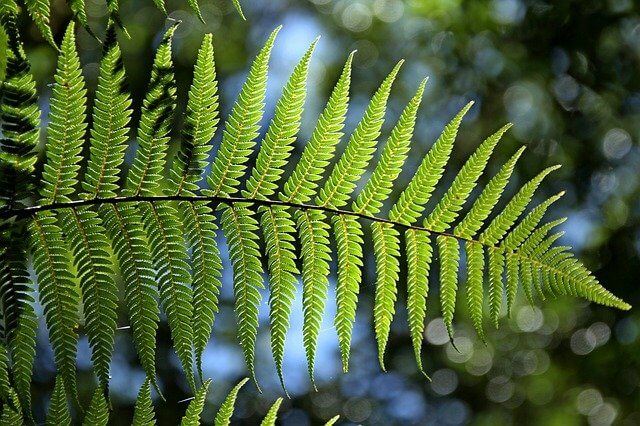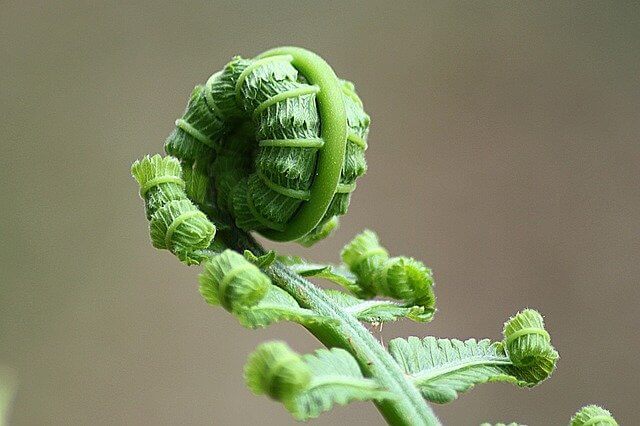Where do ferns grow on earth? Fern species and forests they grow. Information about the ecology and distribution of fern plant?
The majority of species of ferns thrive only in moist or wet regions that are not subject to freezing temperatures. They are particularly abundant in the wet tropics; about 30% of the species grow in tropical rain forests and 40% in subtropical and montane rain forests. Relatively few are found in cold or dry regions. Alpine and tundra areas and coniferous and temperate deciduous forests account for only about 15% of the species, and grasslands, semideserts, and deserts for only 5%. About 10% grow in tropical deciduous forests and scrublands.

Source : pixabay.com
Tropical Rain Forests.
Tropical rain forests are almost constantly wet and hot and provide a great diversity of habitats for ferns. The terrestrial ferns are usually large and often have both fertile and sterile leaves. Even a slight breeze will disperse the spores from the fertile leaves, which are taller than the sterile leaves. Gametophytes grow with difficulty on the rain-washed mud. Many terrestrial species have sporophytes that produce asexual buds, bulbils, or plantlets on their leaves. These outgrowths form little leaves before dropping to the ground or produce little leaves when the parent leaf touches the ground. They produce sporophytes much faster than gametophytes. Also, the new plants are less likely to be buried by mud.
Terrestrial species of Aspleniaceae are particularly abundant in tropical rain forests. A few species are rock dwellers; these often live along streams. They tend to have thick leaves and other modifications to survive occasional drought. Those subject to flooding often have harsh, dissected leaves that withstand flowing water.
Some epiphytes are restricted to tree trunks, shrubs, and other low vegetation. These plants live in the dim light of the forest, are usually thin, and cannot withstand severe drought. Most curl up either temporarily or permanently if water is not abundant. Many are species of Hymenophyllaceae.
A few ferns root in the ground but climb high into the trees. These have fragile gametophytes and young sporophytes that are protected by the forest at ground level. Their mature leaves can withstand strong sunlight and desiccation. Some species of Polypodiaceae that grow on tree trunks and lower branches have leaves close to the trèe that trap humus and provide a place for the fern’s roots.

Source : pixabay.com
The majority of tropical rain forest ferns live only high up in the trees on trunks, branches, or even the leaves of trees. Most are small with thick leaves. The Adiantaceae have abundant root hairs that hold moisture. The Davalliaceae have tightly adherent rhizomes that are protected from water loss by overlapping scales and by leaves that are readily shed. Some of the Elaphoglossaceae are densely scaly.
In places like road cuts and in clearings formerly used for agriculture, species of Gleicheniaceae, Schizaeales, and Cyatheaceae form extensive colonies on more or less bare soil. These species spread by rapidly growing sporophytes or by creeping rhizomes. Their leaves can withstand the intense heat and sunlight common in these areas.
Subtropical and Montane Rain Forests.
Subtropical and montane rain forests are cooler and more constantly wet than tropical rain forests. Because moisture is so constant, both terrestrial and epiphytic species tend to have thinner leaves than those of the tropical rain forests. More light enters these smaller, more open forests. Many species of epiphytic Hymenophyllaceae and Polypodiaceae grow on shrubs and tree branches and trunks. Epiphytic Aspleniaceae and Blechnaceae also are common; terrestrial species with erect rhizomes sometimes resemble miniature tree ferns. In areas with high light intensity or in disturbed soil, species of Gleicheniaceae and Pteridaceae are common. The Cyatheaceae sometimes form dense stands of tree ferns in clearings. At the highest altitudes and on exposed ridges mists are virtually constant. Here trees are dwarfed and covered with mosses and liverworts. Fern gametophytes thrive among these lower plants, and the diversity of epiphytic ferns in such mossy forests is enormous.
Alpine and Tundra Areas and Coniferous Forests.
Many small, deciduous Aspleniaceae grow in alpine and tundra areas. They grow mostly in protected rock crevices or in sheltered ravines. Coniferous forests afford greater protection from intense wind and sunlight. Larger ferns, including many larger Aspleniaceae, are common; these sometimes form extensive colonies.

Source : pixabay.com
Temperate Deciduous Forests.
Temperate deciduous forests are warmer and more diverse than the alpine, tundra, and coniferous forests. Most of the ferns are terrestrial or grow on rocks. A few are aquatic or epiphytic. Species of Ophioglossales, Osmundales, Marsileales, Schizaeales, Pteridaceae, Polypodiaceae, and especially Aspleniaceae are found in temperate deciduous forests. In the equable habitat provided in these forests, structural modifications are few. However, many species are restricted to soils of particular chemical composition or acidity.
Grasslands, Semideserts, and Deserts.
Ferns often show interesting adaptations to their habitats. Temperate and tropical grasslands, semideserts, and deserts offer few habitats for ferns. They are limited largely to boulders and rock outcrops because the gametophytes in particular do not thrive in dense grass or shifting sands. Typically these ferns are adapted to withstand strong sunlight, heat, and drought. The Schizaeales, which have small, highly divided, thick, scaly, hairy, or waxy leaves that curl up in droughts, are common. Many have gametophytes that produce outgrowths that grow directly into sporophytes without fertilization or the water film necessary for it.
Tropical Deciduous Forests and Scrublands.
Tropical deciduous (monsoon) forests and subtropical scrub (mediterranean) forests, which are seasonally dry, contain many terrestrial ferns. The Schizaeales show modifications like those of grassland and desert ferns. Terrestrial ferns less adapted to drought, like the Aspleniaceae, merely shrivel; epiphytes usually also shrivel during drought, but the Polypodiaceae and Davalliaceae lose their leaves entirely, often at a special place near the base of the leafstalk.
mavi